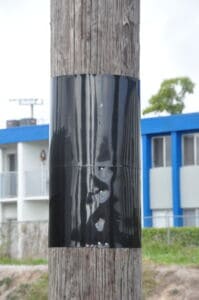
We must manage many factors to assure our systems provide high reliability against a wide array of threats and that includes wildlife. Here are our top wildlife impacts:



Large trees outside of our clearing area can fall on power lines. Photo: Christopher Sessums
Plants & Vegetation
Vegetation grows year-round in Lake Worth Beach and that’s why our vegetation management is also a continuous year-round process. Vegetation can impact lines and equipment from below along property lines with aggressive fast-growing plants like bamboo which can easily grow high enough to clash with power lines and equipment. From above, large trees limbs outside of our clearing easement can crash down on power lines and equipment causing outages.
Iguanas & lizards
Iguanas and lizards are the top animal causes of outages. These exotic creatures have a habit of crawling up our power poles and resting on our equipment in a way that connects the circuit, triggers an outage.



A lizard resting on an insulator. Photo: Jason Bailey
Animal CMI(Total customer minutes interrupted) dropped by nearly two-thirds of 2019 over 2018 due to increased vegetation clearing around power equipment, animal-proof pole wraps in high-risk areas, beefing up cable coverings, and modifying relay settings to reduce false reactions
Birds
Birds can impact equipment when they build a large nests in or between insulators. Birds like Quaker parrots can build nest large enough to connect the wrong elements triggering an outage. Another potential problem area we are analyzing is the impact of large bird populations simultaneously landing and launching from power lines. We have a theory this activity has caused some outages as we have observed more outages in areas where large populations of birds perch such as this one in the area surrounding Lake Osborne.
We are analyzing the impact
of large bird populations
and impact zones
Other Wildlife
Squirrels and racoons often scale poles and perch on top of transformers or crawl between arrestors(surge protectors) and the ground.



A squirrel resting on a power line.
Photo: Christopher Luna
Lake Worth Beach Top Animal Outages 2019






We cleared this high-problem canal bank to lessen the impact of a very active iguana breeding ground near power lines. We have increased our vegetation managment budget to decrease outages in areas like this



Animal proof pole wraps in our high risk areas






For all new construction we are installing new more wildlife proof poles and equipment
Our investment in wildlife solutions are paying off
Animal CMI(Total customer minutes interrupted) dropped by nearly two-thirds of 2019 over 2018. Our animal-related decrease can be attributed to increased vegetation clearing around power equipment, adding animal-proof pole wraps in high-risk areas, beefing up cable coverings, and modifying relay settings to reduce false reactions.
Vegetation related interruptions (CMI) were up nearly 25% in 2019 vs 2018. This increase can primarily be attributed to three incidents involving “feeder” lines which serve a large number of customers. We have increased our investment in vegetation management from 400k to 600k and expect we are already seeing the effect of our additional efforts on improved reliability
Additional investments we are making to better prevent, identify and address outages from all causes include:
- For new construction, we are installing equipment with multiple innovations that make the equipment far less vulnerable to animal or vegetation impact.
- For faster and more accurate identification of outage causes and locations, we are installing devices across our network that immediately alert our response teams as to the location of the outage. These devices will help us respond and address issues faster by greatly narrowing the outage target areas for our dispatched teams.
- We continue to analyze and modify our relay settings to reduce the number of unnecessary outages from over-sensitive reactions to animal or vegetation impacts.

